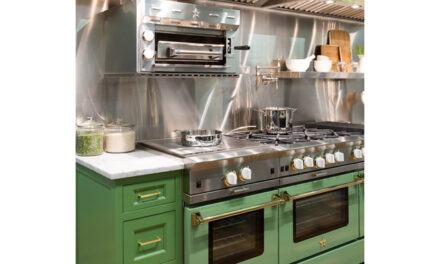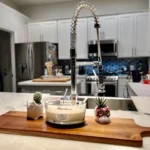Welcome to Nilufer Home Kitchen Magic: Inspiring Your Culinary Creativity, where every meal is a celebration of flavor and tradition. Nestled in the heart of a cozy neighborhood, our kitchen is more than just a place where food is prepared—it’s where passion and creativity come together to craft memorable dining experiences. At Nilufer’s, we believe that great food starts with fresh, high-quality ingredients and a touch of love.
Our menu is a reflection of diverse culinary influences, blending time-honored recipes with innovative twists. From the savory aroma of our homemade spices to the vibrant colors of our carefully curated dishes, every bite tells a story of rich heritage and contemporary flair. Whether you’re joining us for a casual brunch, a festive dinner, or simply to enjoy a delightful treat, our homey atmosphere and attentive service promise to make you feel right at home.
In Nilufer’s Home Kitchen, we’re not just serving meals; we’re creating experiences that linger long after the last crumb is gone. Join us at our table and discover the joy of authentic, lovingly prepared cuisine that celebrates the art of good eating and the pleasure of sharing a meal with loved ones.
Nilufer Home Kitchen Magic: Inspiring Your Culinary Creativity
This detailed guide will explore how you can harness the magic of your home kitchen, drawing inspiration from our unique approach to cooking and offering practical tips and techniques to elevate your culinary game.For more information visit here
Table of Contents
Embracing the Heart of Your Kitchen
Your kitchen is the heart of your home—a place where memories are made, and nilufer home kitchen come to life. To create a magical cooking experience, start by making your kitchen a space that inspires you.
Personalize Your Space
Infuse your kitchen with elements that reflect your personality and culinary interests. Decorate with items that bring you joy, such as colorful kitchen towels, artistic cookware, or a well-curated spice rack. Consider adding a herb garden on your windowsill or a chalkboard wall for jotting down recipes and inspiration.
Invest in Quality Tools
Good tools make a significant difference in the nilufer home kitchen. Invest in high-quality knives, sturdy pots and pans, and essential gadgets. These tools will not only make your cooking more enjoyable but also enhance the quality of your dishes.
Organize Efficiently
A well-organized kitchen can boost your creativity and efficiency. Use clear containers for pantry items, label everything, and keep your workspace clutter-free. An organized kitchen allows you to focus on the art of cooking rather than searching for ingredients.
Cultivating Culinary Creativity
Creativity in the nilufer home kitchen is about more than just trying new recipes—it’s about experimenting and finding your unique cooking style.
Explore Global Cuisines
Expand your culinary horizons by exploring dishes from different cultures. Each cuisine offers unique flavors, techniques, and ingredients that can inspire new creations. Try cooking a Thai curry, Italian pasta, or Indian biryani to add variety to your meals.
Experiment with Ingredients
Don’t be afraid to mix and match ingredients. Substitute traditional items with unexpected alternatives to create new flavor profiles. For example, use quinoa instead of rice or coconut milk instead of cream. Experimenting with ingredients can lead to delightful discoveries.
Create Your Signature Dish
Develop a signature dish that represents your cooking style and flavor preferences. It could be a twist on a classic recipe or an entirely new creation. A signature dish nilufer home kitchen allows you to showcase your culinary identity and offers a personal touch to your cooking.
Mastering Essential Techniques
While creativity is key, mastering essential nilufer home kitchen cooking techniques ensures that your experiments yield delicious results.
Knife Skills
Proper knife skills are crucial for efficient and precise cooking. Practice techniques nilufer home kitchen such as chopping, dicing, and julienning. A sharp knife and proper technique will make your prep work faster and more enjoyable.
Cooking Methods
Understand and master various cooking methods, including sautéing, roasting, grilling, and baking. Each method imparts different flavors and textures to ingredients. Experiment with these techniques to find the best ways to prepare your favorite dishes.
Flavor Balancing
Balancing flavors is essential for creating nilufer home kitchen harmonious dishes. Learn to adjust the levels of sweetness, acidity, saltiness, and bitterness to achieve a well-rounded taste. Tasting and adjusting as you cook will help you develop your palate and improve your dishes.

Crafting Memorable Meals
Creating memorable meals is about more than just the food—it’s about the entire dining experience.
Presentation Matters
The presentation of your dishes can elevate the dining experience. Use colorful ingredients, nilufer home kitchen garnish with fresh herbs, and arrange your plates thoughtfully. Beautiful presentation enhances the visual appeal and makes the meal feel special.
Pairing Flavors
Pairing flavors effectively can elevate a meal from good to great. Learn about complementary flavors and how to combine them. For example,nilufer home kitchen pairing citrus with seafood or earthy herbs with roasted vegetables can create balanced and exciting dishes.
Creating Atmosphere
Set the scene for your meals by creating a pleasant dining atmosphere. Use nice tableware, light candles, and play soft music to enhance the experience. A well-set table and a relaxed atmosphere make mealtime more enjoyable and memorable.
Sharing the Joy
Cooking is a social experience, and sharing your creations with others can bring immense joy.
Hosting Gatherings
Invite friends and family to enjoy your nilufer home kitchen culinary creations. Hosting gatherings provides an opportunity to showcase your cooking skills and share your love of food. Plan menus that cater to your guests’ preferences and dietary needs.
Cooking with Loved Ones
Get your loved ones involved in the cooking process nilufer home kitchen. Cooking together can be a fun and bonding experience. Whether it’s baking cookies with kids or preparing a meal with a partner, shared cooking activities create lasting memories.
Sharing Recipes
Share your favorite recipes with friends, family, and even online communities. This not only allows others to enjoy your dishes but also helps you connect with fellow food enthusiasts and exchange culinary ideas.
Continuing Your Culinary Journey
The journey of culinary creativity is ongoing, and there is always more to learn and explore.
Taking Cooking Classes
Consider taking cooking classes nilufer home kitchen to expand your skills and knowledge. Classes offer hands-on experience and expert guidance in various cuisines and techniques. Whether online or in-person, cooking classes provide valuable learning opportunities.
Reading and Researching
Stay inspired by reading cookbooks, food blogs, and culinary magazines. Research new ingredients, techniques, and trends to keep your cooking fresh and exciting. Learning about food history and culture can also enhance your culinary creativity.
Embracing Seasonal Ingredients
Cooking with seasonal ingredients ensures that your dishes are nilufer home kitchen fresh and flavorful. Explore local farmers’ markets and seasonal produce to discover new ingredients and flavors. Seasonal cooking also connects you with the natural rhythms of food production.
Developing Your Culinary Palette
Your culinary palette is your unique sense of taste, and developing it is key to refining your cooking skills.
Understanding Flavor Profiles
A well-developed palette starts with understanding different flavor profiles. These include sweet, salty, sour, bitter, and umami. Each ingredient contributes to these categories in different ways, and learning how to balance them is fundamental to creating delicious meals.
For example:
- Sweetness can come from ingredients nilufer home kitchen like fruits, honey, or certain vegetables like carrots and sweet potatoes.
- Salty elements often derive from salts, cheeses, and cured meats, but herbs and umami-rich ingredients like soy sauce also add depth to this profile.
- Sourness from citrus fruits, vinegars, and fermented foods can bring brightness and contrast.
- Bitterness from ingredients like coffee, kale, and dark chocolate adds complexity and contrast when used thoughtfully.
- Umami is the “savory” profile, often found in mushrooms, tomatoes, soy sauce, and aged cheeses.
Palate Training Exercises
To sharpen your palate, try tasting various ingredients individually. Eat them slowly and mindfully, paying attention to the subtle nuances in flavor. You can also take two similar ingredients, like two different types of apples, and compare their taste, sweetness, and texture. This simple practice enhances your ability to detect subtle flavor differences in dishes.
Cooking Without Recipes
Once you’ve developed a strong sense of flavor profiles and balance, challenge yourself to cook nilufer home kitchen without relying heavily on recipes. Start with ingredients you enjoy and think about how different flavor combinations work together. Cooking without a strict recipe encourages intuition and helps you create meals that are uniquely yours.
Creating a Pantry of Possibilities
Your pantry is your culinary toolkit, and having a well-stocked and thoughtfully curated pantry gives you endless possibilities for creativity.
The Basics
There are certain pantry staples that every home kitchen should have to ensure you’re ready to whip up a meal at any time:
- Oils: Olive oil, vegetable oil, sesame oil
- Vinegars: Balsamic, white wine, rice vinegar
- Grains: Rice, quinoa, pasta, couscous
- Legumes: Canned or dried beans, lentils, chickpeas
- Spices and Seasonings: Salt, pepper, cumin, paprika, turmeric, cinnamon, herbs (fresh or dried)
- Canned Goods: Tomatoes, coconut milk, tuna
- Baking Essentials: Flour, sugar, baking powder, and yeast
Global Flavors in Your Pantry
Incorporating global ingredients into your pantry nilufer home kitchen allows you to experiment with a wide range of culinary traditions. Consider adding these ingredients to diversify your pantry:
- Soy sauce, fish sauce, and miso for Asian-inspired dishes
- Harissa, za’atar, and preserved lemons for Middle Eastern flavors
- Curry paste and garam masala for Indian cuisine
- Tahini and pomegranate molasses for Mediterranean influences
- Chili flakes, sriracha, and chipotle peppers for Latin and South American dishes
Having these ingredients on hand helps you experiment with different flavors without needing to plan extensively or purchase new items for each dish.
Build Your Spice Collection
Spices are the key to unlocking complex flavors. Start with the basics, such as salt, pepper, and cumin, then slowly expand your collection by incorporating spices like star anise, cardamom, sumac, and saffron. Freshly ground spices tend to have a more vibrant flavor than pre-ground options, so nilufer home kitchen invest in a spice grinder or a mortar and pestle if possible.
Reinventing Leftovers
Leftovers don’t have to be boring. With a bit of creativity, you can transform yesterday’s meal into a new culinary experience.
. Turning Leftovers into New Dishes
For example:
- Roast Chicken: The next day, shred it and use it in tacos, salads, or sandwiches.
- Cooked Vegetables: Blend them into a soup, add them to a frittata, or make a veggie stir-fry.
- Cooked Rice: Transform it into fried rice, rice pudding, or even a hearty rice salad.
Freezing Leftovers
Freezing is an excellent way to avoid food waste and have meals ready for later. When freezing leftovers, be sure to store them in airtight containers, label them with the date, and portion them out to make reheating easier.
Batch Cooking for Convenience
If you have a busy schedule, consider batch cooking nilufer home kitchen on weekends and freezing meals in individual portions. Soups, stews, and casseroles freeze particularly well, making them ideal candidates for batch cooking. This practice ensures you always have a homemade meal ready, even on the busiest days.. Cooking for Dietary Preferences and Restrictions
In today’s world, it’s increasingly common to cook for people with various dietary needs or preferences. Whether you’re accommodating food allergies, lifestyle choices, or cultural preferences, being able to adapt your cooking is a valuable skill.
Understanding Special Diets
Here are some common dietary nilufer home kitchen restrictions and how to cater to them:
- Vegetarian or Vegan: Focus on plant-based proteins like beans, lentils, and tofu. Experiment with hearty grains, vegetables, and nuts to create satisfying and balanced meals.
- Gluten-Free: Use gluten-free grains like rice, quinoa, and buckwheat. Many gluten-free flours, such as almond or coconut flour, are available for baking.
- Dairy-Free: Opt for plant-based milk alternatives like almond, soy, or oat milk. Coconut milk is a rich substitute in savory dishes, and olive oil or vegan butter can replace butter in cooking.
- Low-Carb/Keto: Incorporate more healthy fats like avocado and olive oil. Substitute traditional carbs with vegetables like cauliflower (cauliflower rice or mashed) and zucchini (zoodles).
Ingredient Substitutions
Learning how to substitute ingredients is essential for accommodating dietary restrictions while maintaining flavor and texture. For example:
- Milk alternatives like almond or oat milk can replace dairy in most recipes.
- Chickpea flour can substitute for wheat flour in many savory recipes.
- Flaxseeds or chia seeds mixed with water can be used as egg replacements in baking.
Adapting recipes to fit dietary needs challenges you to think creatively and discover new culinary possibilities.
Sustainability in the Kitchen
Sustainability is a growing concern in the culinary world, and making eco-conscious choices in the nilufer home kitchen can contribute to a healthier planet.
Reducing Food Waste
One of the most effective ways to promote sustainability in your nilufer home kitchen is by minimizing food waste. Plan your meals carefully, use leftovers creatively, and store food properly to extend its shelf life. Composting food scraps is another great way to reduce waste while enriching your garden.
Choosing Sustainable Ingredients
When possible, buy organic, locally sourced, and seasonal ingredients. Support farmers who use sustainable and ethical farming practices. Additionally, reduce your consumption of single-use plastic by opting for reusable containers and bags.
Meatless Meals
Incorporating more plant-based meals into your weekly routine can reduce your carbon footprint. You don’t need to go fully vegetarian or vegan—just introducing a “Meatless Monday” tradition in your home can make a difference.
Celebrating the Seasons
Cooking with the seasons not only ensures the freshest and most flavorful ingredients, but it also brings variety and creativity to your nilufer home kitchen.
Seasonal Produce Guide
Learn which fruits and vegetables are in season throughout the year:
- Spring: Asparagus, peas, rhubarb, and strawberries
- Summer: Tomatoes, zucchini, peaches, and corn
- Fall: Squash, apples, mushrooms, and brussels sprouts
- Winter: Root vegetables like sweet potatoes, turnips, citrus fruits, and kale
To sum up
Nilufer Home Kitchen A call to discover, create, and appreciate the beauty of home cooking, magic is more than just a handbook. Creative expression, personal development, and happiness may be found in abundance in the kitchen, regardless of experience level. Every meal may be a platform for expression when prepared with the appropriate attitude, equipment, and components.
In the universe of Nilufer, cooking is an act of soul nourishment as much as physical sustenance. Allow your culinary imagination to flow, explore new flavours, and enjoy the wonder of cooking in your own kitchen. In your kitchen, magic happens every day—whether you’re cooking up new recipes, entertaining family and friends, or just having a peaceful lunch by yourself.










